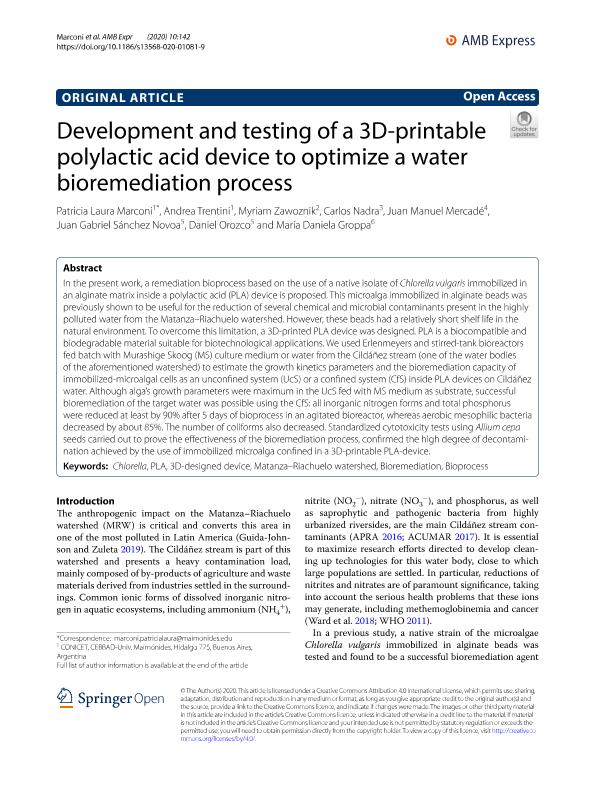Artículo
Development and testing of a 3D-printable polylactic acid device to optimize a water bioremediation process
Marconi, Patricia Laura ; Trentini, Andrea Giannina
; Trentini, Andrea Giannina ; Zawoznik, Myriam Sara; Nadra Chaud, Carlos Alberto; Mercadé, Juan José; Sanchez Novoa, Juan Gabriel; Orozco, Daniel; Groppa, María Daniela
; Zawoznik, Myriam Sara; Nadra Chaud, Carlos Alberto; Mercadé, Juan José; Sanchez Novoa, Juan Gabriel; Orozco, Daniel; Groppa, María Daniela
 ; Trentini, Andrea Giannina
; Trentini, Andrea Giannina ; Zawoznik, Myriam Sara; Nadra Chaud, Carlos Alberto; Mercadé, Juan José; Sanchez Novoa, Juan Gabriel; Orozco, Daniel; Groppa, María Daniela
; Zawoznik, Myriam Sara; Nadra Chaud, Carlos Alberto; Mercadé, Juan José; Sanchez Novoa, Juan Gabriel; Orozco, Daniel; Groppa, María Daniela
Fecha de publicación:
12/2020
Editorial:
Springer
Revista:
AMB Express
ISSN:
2191-0855
Idioma:
Inglés
Tipo de recurso:
Artículo publicado
Clasificación temática:
Resumen
In the present work, a remediation bioprocess based on the use of a native isolate of Chlorella vulgaris immobilized in an alginate matrix inside a polylactic acid (PLA) device is proposed. This microalga immobilized in alginate beads was previously shown to be useful for the reduction of several chemical and microbial contaminants present in the highly polluted water from the Matanza–Riachuelo watershed. However, these beads had a relatively short shelf life in the natural environment. To overcome this limitation, a 3D-printed PLA device was designed. PLA is a biocompatible and biodegradable material suitable for biotechnological applications. We used Erlenmeyers and stirred-tank bioreactors fed batch with Murashige Skoog (MS) culture medium or water from the Cildáñez stream (one of the water bodies of the aforementioned watershed) to estimate the growth kinetics parameters and the bioremediation capacity of immobilized-microalgal cells as an unconfined system (UcS) or a confined system (CfS) inside PLA devices on Cildáñez water. Although alga’s growth parameters were maximum in the UcS fed with MS medium as substrate, successful bioremediation of the target water was possible using the CfS: all inorganic nitrogen forms and total phosphorus were reduced at least by 90% after 5 days of bioprocess in an agitated bioreactor, whereas aerobic mesophilic bacteria decreased by about 85%. The number of coliforms also decreased. Standardized cytotoxicity tests using Allium cepa seeds carried out to prove the effectiveness of the bioremediation process, confirmed the high degree of decontamination achieved by the use of immobilized microalga confined in a 3D-printable PLA-device.
Archivos asociados
Licencia
Identificadores
Colecciones
Articulos(SEDE CENTRAL)
Articulos de SEDE CENTRAL
Articulos de SEDE CENTRAL
Citación
Marconi, Patricia Laura; Trentini, Andrea Giannina; Zawoznik, Myriam Sara; Nadra Chaud, Carlos Alberto; Mercadé, Juan José; et al.; Development and testing of a 3D-printable polylactic acid device to optimize a water bioremediation process; Springer; AMB Express; 10; 1; 12-2020; 1-9
Compartir
Altmétricas



